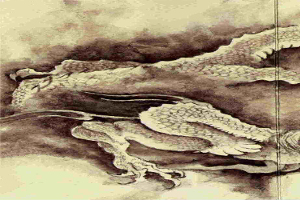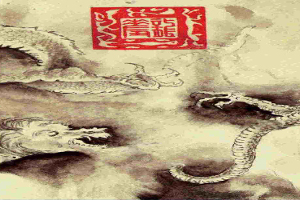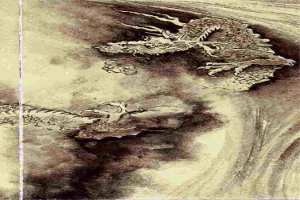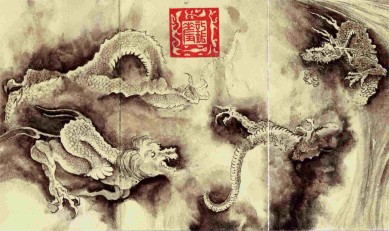 The Scroll of the Nine Dragon Sons was painted by Chén Róng (陈容, 1210-1261AD) and depicts nine dragons as they chase each other across the sky. It is a beautiful painting full of energy and mystery. The dragons climb over hills and seem immersed in a mist. They play among clouds, wind, whirlpools, fire and cliffs.
The Scroll of the Nine Dragon Sons was painted by Chén Róng (陈容, 1210-1261AD) and depicts nine dragons as they chase each other across the sky. It is a beautiful painting full of energy and mystery. The dragons climb over hills and seem immersed in a mist. They play among clouds, wind, whirlpools, fire and cliffs.
The Nine Dragons Scroll is absolutely huge. It is nearly half a meter wide and over ten metres long (46.3 x 1096.4 cm). The painting itself is overlaid with inscriptions some by the author others by scholars and collectors. There are also many stamps that have been added as well. A number of eulogies are either attached or added to the scroll, probably by Daoists scholars. A full and detailed rendering of these can be found in the JSTOR archive in a study by Hsien-chi Tseng published in 1957 (see the link below).
According to the artist’s poem written at the end of the painting, this work was inspired by a painting Nine Horses by the 8th century painter Can Ba and a Nine Deer attributed to Huichong. Chen Rong’s poem recounts how he was able to paint the dragons while he was in an intoxicated state of mind, reflecting certain mind-altering experiences and insights long associated with Daoist transcendental practices. There is an excellent interactive viewer for the scroll provided here by the University of Chicago which shows the scroll in its full glory.
To Daoists, dragons represented the Way, they reveal themselves then vanish in mystery. The nine dragons in this scroll represent the nine sons of the Dragon King. Thus they represent the nine natures of the Dragon King and are manifestations of the Way of Nature found in the Dao De Jing (道德經, Dào Té Jīng). Each has its own character and particular roles to play in the stories that are told about it. For example the history of the Nine Dragon Sons tells us that:
- Baxia is said to be a good swimmer, he can often be seen on bridges watching those in boats.
- Bixi can be found on baskets and packs, for he is a grand pack-animal.
- Chiwen has great sight and loves to gaze in the distance and mountain tops bare his image.
- Haoxian is a reckless adventurer, so the eves and columns of buildings are decorated with him.
- Jiaotu is tight-lipped and doors bear his image as he has a great skill at protecting the home.
- Pulao had a grand roar; therefore, his figure is carved onto bells.
- Qiuniu decorates musical instruments because he loves music and his voice is loud and true.
- Suanmi can be seen on incense burners, for he is fond of smoke and fire.
- Yazi can be found on weapons, like knives and swords, for he is very warlike and brave.
It is worth noting that the number 9 (九, jiŭ) is of significance here. If you multiply 9 by any of the numbers from 1-9, and then add the numbers of the result to one another, you will always end up with 9. It is said that the dragon is made from nine different animals and that it has 81 scales on its back (9×9=81). The number 9 was historically associated with the emperor in ancient China and it also symbolises harmony. Moreover, the number 9 is a homophone of the word for “long lasting” (久, jiǔ), thus it is associated with longetivity.
The painting depicts the ever-lasting movement of the world, the apparent chaos of the universe. The dragons appear in this chaotic world as magnificent beasts that represent, in the Chinese mind strength, goodness and benevolence. In Chinese mythology the dragon embodies all the potent forces of nature and this dramatic painting expresses the majesty of these forces in ink. The dragon is often thought of as a manifestation of qi, or cosmic force. It is often associated with the ability to bring forth rain, which of course nourishes life. This is the yin energy. Where as the dragons association with light and fire is the yang energy. In the painting one of the dragons clutches a pearl, the symbol of the north star, the original qi from which the universe emerged. The interplay of the dragons in the painting only appears chaotic. In fact the dragons, as forces of nature, bring harmony to the world. The movement between them appears to be the movement between yin and yang.
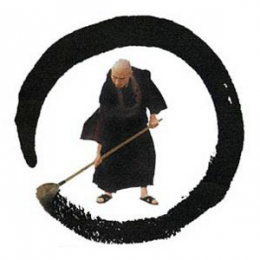






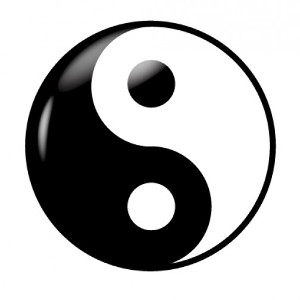 China Tai Chi Guide
China Tai Chi Guide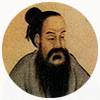 Five Elements Academy
Five Elements Academy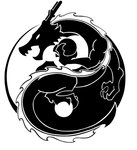 Long Tou Shan Tai Chi School
Long Tou Shan Tai Chi School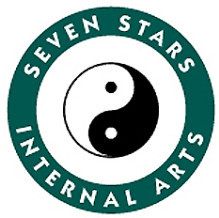 Seven Stars Internal Arts
Seven Stars Internal Arts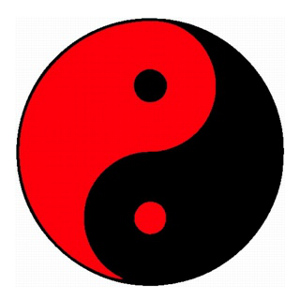 Traditional Tai Chi School
Traditional Tai Chi School Wandering Dao, China
Wandering Dao, China